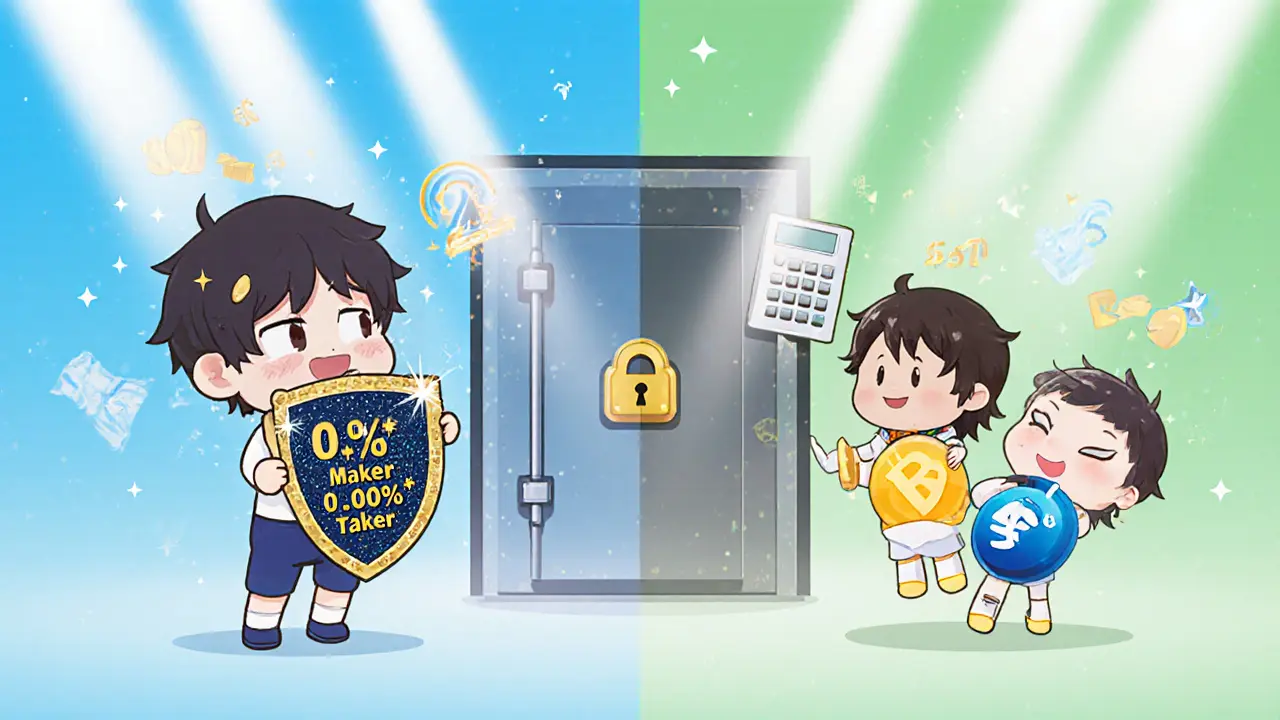Zaif Crypto Exchange Fee Calculator
Fee Comparison Tool
Compare Zaif's fee structure with major global exchanges.
Zaif Fees
Maker Fee: 0%
Taker Fee: 0.10%
Estimated Cost: ¥0
Binance Fees
Maker Fee: 0.02%
Taker Fee: 0.04%
Estimated Cost: ¥0
Coinbase Fees
Maker Fee: 0%
Taker Fee: 0.50%
Estimated Cost: ¥0
Savings Analysis
You save ¥0 vs Binance
You save ¥0 vs Coinbase
Tip: With Zaif's zero-maker fees, you'll save more on limit orders. For a ¥1,000,000 trade:
• Zaif: ¥1,000 (0.10%)
• Binance: ¥4,000 (0.04%)
• Coinbase: ¥5,000 (0.50%)
Looking for a regulated Japanese platform to trade Bitcoin against the yen? Zaif crypto exchange review breaks down everything you need to know before you deposit a single yen.
Quick Takeaways
- Zero‑maker fees and 0.10% taker fees make it one of the cheapest Japanese spot markets.
- Licensed by the Japan Financial Services Authority (JFSA), so you get legal consumer protection.
- Security was reinforced after the 2018 hack that stole ~7billionJPY; cold‑storage, multi‑sig withdrawals and mandatory 2FA are now standard.
- Only 24 crypto assets are available - great for Bitcoin‑JPY traders, limited for altcoin hunters.
- Leverage tops out at 4:1, far lower than many global rivals.
What Is Zaif?
Zaif is a Japanese cryptocurrency exchange operating since April2016. It began as Tech Bureau Inc., was acquired by FISCO Digital Asset Group in 2018, and now runs under Caica Exchange Inc. Headquartered in Tokyo, Zaif primarily serves traders who want to move Japanese Yen (JPY) into digital assets, especially Bitcoin (BTC).
Regulatory Backbone
In Japan, the Japan Financial Services Authority (JFSA) issues a strict license for crypto exchanges. Zaif was among the first to receive this approval, which means it must meet capital, AML, and consumer‑protection standards that many offshore platforms ignore. Membership in the Japan Cryptocurrency Exchange Association further signals compliance.
Fee Structure & Trading Mechanics
Zaif’s fee model is simple: makers pay 0% and takers pay 0.10% per trade. For a trader moving ¥1000000 in volume, the taker cost would be ¥1000 - a fraction of what you’d pay on Binance (0.02% maker, 0.04% taker) or Coinbase (0.00% maker, 0.50% taker for crypto‑JPY pairs).
Spot trading is the core offering, but a margin product exists with a maximum 4:1 leverage for retail users. The platform also provides a native ZAIF token (tickerZAIF) that can be staked for small passive‑income rewards via the Coin Reserve feature.

Security Track Record
The 2018 incident remains a talking point: roughly ¥7billion (about $60million) vanished from hot wallets. After the breach, FISCO overhauled the security stack. Current safeguards include:
- SSL/TLS encryption for all web traffic.
- Cold‑storage of ≥95% of user funds.
- Multi‑signature (multi‑sig) withdrawal approvals.
- Mandatory two‑factor authentication (2FA) for login and withdrawals.
Asset Selection & Trading Tools
Zaif lists 24 crypto assets, heavily weighted toward BTC/JPY, ETH/JPY, and a handful of popular altcoins such as XRP, LTC, and LINK. The limited roster may deter traders chasing newer DeFi tokens, but it simplifies the UI for newcomers.
Charting tools include standard candlesticks, Bollinger Bands, and moving averages. An API is available for algorithmic trading, and the Coin Reserve product lets users earn a modest yield by locking ZAIF tokens.
User Experience, Support & Onboarding
Signing up demands a full KYC flow: identity document upload, proof of residence, and a questionnaire about financial background. The process can take 1‑2business days, longer than the instant verification on some global exchanges, but it satisfies JFSA’s anti‑money‑laundering mandates.
Customer support is reachable via email and a Japanese‑language chat widget. Users often praise the staff’s politeness, though exact response times aren’t publicly disclosed. The platform’s web traffic data (≈703k monthly organic visits) points to a steady, engaged user base.
Pros & Cons at a Glance
| Feature | Zaif | Binance | Coinbase |
|---|---|---|---|
| Maker Fee | 0% | 0.02% | 0% |
| Taker Fee | 0.10% | 0.04% | 0.50% |
| Leverage Max | 4:1 | 125:1 | 3:1 (US only) |
| Supported Fiat | JPY | USD, EUR, etc. | USD, EUR, GBP |
| Asset Count | 24 | ≈600 | ≈300 |
| Regulatory License | JFSA (Japan) | None (off‑shore) | NYDFS, FCA, etc. |
In short, Zaif shines on fees and regulatory comfort, but falls short on asset variety and high‑risk leverage.
Should You Trade on Zaif?
If you are a Japan‑based trader who wants low‑cost Bitcoin‑JPY exposure and values a JFSA‑licensed environment, Zaif is a solid pick. The platform’s fee structure and compliance outweigh its narrower market and modest leverage.
Conversely, if you need a broad altcoin selection, higher leverage, or the ability to fund with USD/EUR, you’ll likely look elsewhere. International traders should also note that Zaif only accepts JPY deposits, so a currency conversion step is required.

Frequently Asked Questions
Is Zaif safe after the 2018 hack?
Yes, the exchange revamped its security architecture. Funds are now stored cold, withdrawals need multi‑signature approval, and 2FA is mandatory. While no platform is 100% risk‑free, industry analysts consider Zaif among the safer Japanese exchanges.
Can I trade non‑JPY pairs on Zaif?
Zaif focuses on JPY‑denominated pairs. You’ll find BTC/JPY, ETH/JPY, and a few other crypto‑JPY pairs, but no USD or EUR markets.
What is the native ZAIF token used for?
ZAIF can be staked in the Coin Reserve product to earn a small yield. It also serves as a utility token for fee discounts and platform‑specific promotions.
How long does KYC verification take?
Typically 1-2business days, assuming your documents are clear and you answer the financial questionnaire promptly.
Is there a mobile app for Zaif?
Yes, Zaif offers iOS and Android apps that mirror the web interface, including 2FA integration and push notifications for order fills.







John Kinh
November 25, 2024 AT 19:23Zero‑maker fees? Sign me up! 🚀
Nathan Blades
November 25, 2024 AT 20:46Zaif’s zero‑maker fee model is a rare gem in the crypto world.
For traders who place limit orders, that means you literally pay nothing on the maker side.
The taker fee of 0.10% still beats most global exchanges, especially when you convert the numbers into JPY.
Compared to Binance’s 0.04% taker fee, the absolute cost can be higher for small trades, but the margin narrows as volume grows.
The platform’s licensing by the JFSA adds a layer of consumer protection that many offshore venues simply lack.
This regulatory oversight forces Zaif to keep a certain capital reserve and to implement robust AML procedures.
After the 2018 hack, the exchange overhauled its security stack, moving over 95% of assets into cold storage.
Multi‑signature withdrawal approval and mandatory 2FA are now standard, reducing the attack surface considerably.
While no exchange is immune to insider threats, the transparent post‑hack improvements have earned Zaif a solid reputation among Japanese traders.
The limited asset list of 24 coins keeps the UI clean, which is great for newcomers who might be overwhelmed elsewhere.
However, power users looking for the latest DeFi tokens will find Zaif’s catalogue underwhelming.
The 4:1 leverage cap is modest compared to the 125:1 on Binance, but it aligns with Japan’s stricter risk‑management stance.
For Japanese residents, the ability to fund directly with JPY simplifies the whole process, eliminating a costly fiat conversion step.
The native ZAIF token offers modest staking rewards, but it’s not a game‑changing feature.
In summary, if you value low fees, regulatory certainty, and a secure environment over an expansive altcoin menu, Zaif is worth a serious look.
Somesh Nikam
November 25, 2024 AT 22:09The KYC process can feel a bit slow, but it’s an essential safety net that protects both the exchange and its users. By verifying identity and residence, Zaif meets the JFSA’s strict AML standards, which ultimately builds trust in the platform. Most users report a turnaround of 1‑2 business days when documents are clear, so planning ahead is wise. Once cleared, you’ll enjoy seamless fiat deposits and withdrawals in JPY without extra hurdles.
Prince Chaudhary
November 25, 2024 AT 23:33Respectfully, the fee advantage is clear, yet it’s worth noting that the limited asset selection might restrict diversification. For traders focused primarily on BTC/JPY and a few major altcoins, Zaif is a solid choice; for those chasing newer tokens, you’ll need to look elsewhere.
Sidharth Praveen
November 26, 2024 AT 00:56Keeping it simple works wonders – Zaif’s low fees and JPY‑only focus make it perfect for newcomers, and the 4:1 leverage keeps risk in check while still offering some margin excitement.
Sophie Sturdevant
November 26, 2024 AT 02:19From a liquidity depth standpoint, Zaif’s order book may appear thin compared to larger exchanges, but the tight spread on BTC/JPY ensures competitive execution. The absence of a tiered maker‑taker schedule simplifies fee calculations, which is a boon for algorithmic traders who prefer deterministic cost structures.
Jan B.
November 26, 2024 AT 03:43Zaif offers low fees. It is regulated. The interface is clean.
MARLIN RIVERA
November 26, 2024 AT 05:06Zaif is a relic clinging to outdated regulations. Its limited coin list and low leverage make it pointless for serious traders. Avoid it unless you have no other options.
Debby Haime
November 26, 2024 AT 06:29Overall, Zaif hits a sweet spot for Japanese users who want a trustworthy, low‑fee platform. The security upgrades post‑hack are reassuring, and the JFSA licence adds peace of mind.
emmanuel omari
November 26, 2024 AT 07:53Our continent’s exchanges have proven they can provide better liquidity and more diverse token listings without sacrificing security. Zaif’s narrow focus feels like a step backward compared to the innovations happening elsewhere.
Andy Cox
November 26, 2024 AT 09:16Interesting read. The JPY focus makes sense for locals. The fee structure is simple enough for most people.
Courtney Winq-Microblading
November 26, 2024 AT 10:39When we talk about trust in a financial platform, it’s not just about cold‑storage or 2FA; it’s about the ethos behind regulation. Zaif’s alignment with the JFSA reflects a broader philosophical commitment to consumer protection, which resonates with users who value security over sheer variety.
katie littlewood
November 26, 2024 AT 12:03Zaif’s user experience feels like a breath of fresh air-clean, uncluttered, and purpose‑built for the JPY market. The limited roster of 24 assets actually helps newcomers avoid the analysis paralysis that can happen on mega‑exchanges with hundreds of pairs. The onboarding flow, while a bit longer due to rigorous KYC, reinforces the feeling that the platform takes your safety seriously. Moreover, the fee calculator widget embedded on the site demystifies cost calculations, letting users see instantly how a ¥1,000,000 trade translates into a ¥1,000 taker fee. The native ZAIF token, though not a big profit driver, adds a subtle incentive layer for loyal users willing to stake. Security‑wise, the post‑hack overhaul with multi‑sig withdrawals and a 95% cold‑storage policy demonstrates a commitment to learning from past mistakes. The 4:1 leverage ceiling may feel modest, but it aligns with Japan’s prudent stance on risk, which many traders appreciate as a safeguard against catastrophic liquidations. While the lack of DeFi‑centric tokens might turn away yield‑farmers, it keeps the platform’s focus narrow and manageable. In short, Zaif offers a balanced blend of low fees, regulatory assurance, and a user‑friendly interface that makes it a solid choice for anyone anchored in the Japanese crypto ecosystem.
Jenae Lawler
November 26, 2024 AT 13:26In an era where exchanges vie for market share through endless token listings, Zaif’s parsimonious approach appears antiquated. Yet, one must concede that its regulatory compliance and fee simplicity provide a niche advantage for risk‑averse participants.
Chad Fraser
November 26, 2024 AT 14:49Hey folks, if you’re looking for a low‑fee, JPY‑centric exchange with solid security, give Zaif a try. The community is friendly and the support team is quick to help.
Prince Chaudhary
November 26, 2024 AT 16:13I concur with the assessment that Zaif’s regulatory backing is its strongest suit; the trade‑off is indeed a narrower coin selection, which may limit certain strategies.
John Kinh
November 26, 2024 AT 17:36Well said!